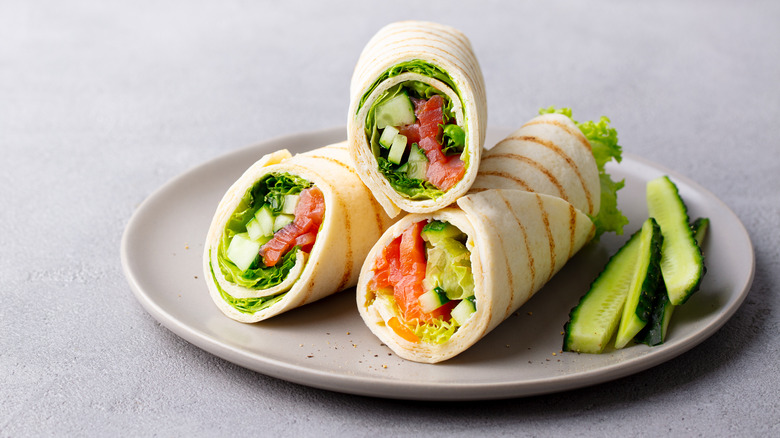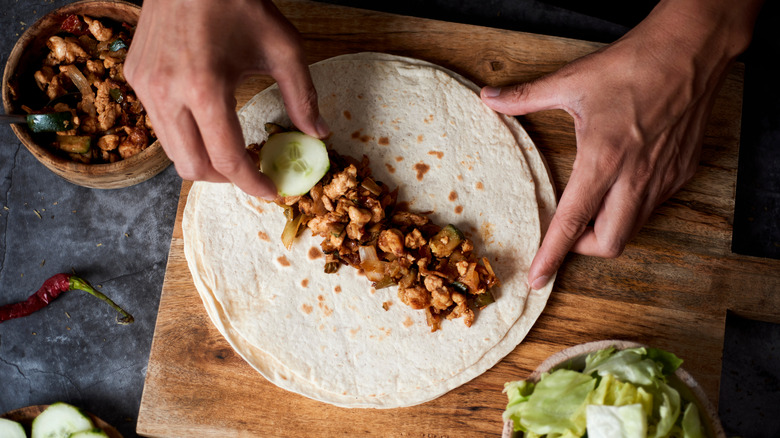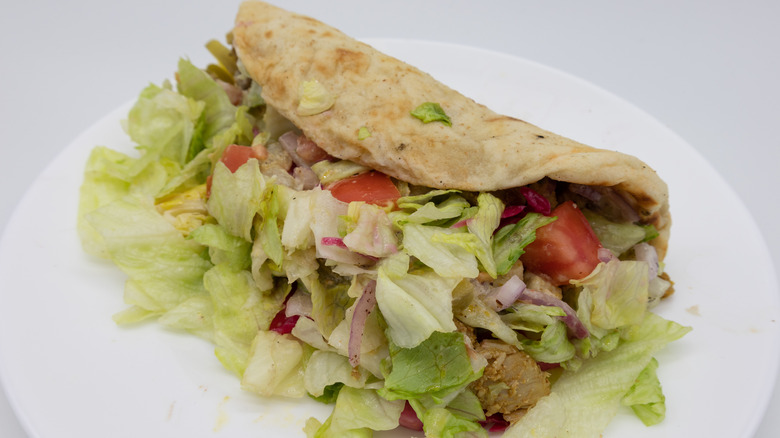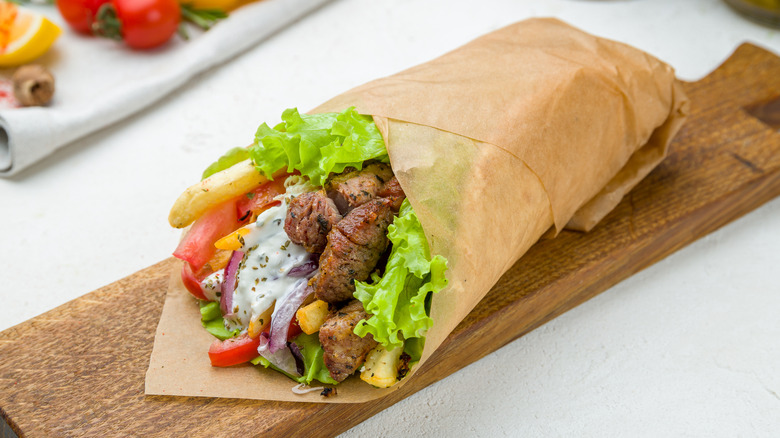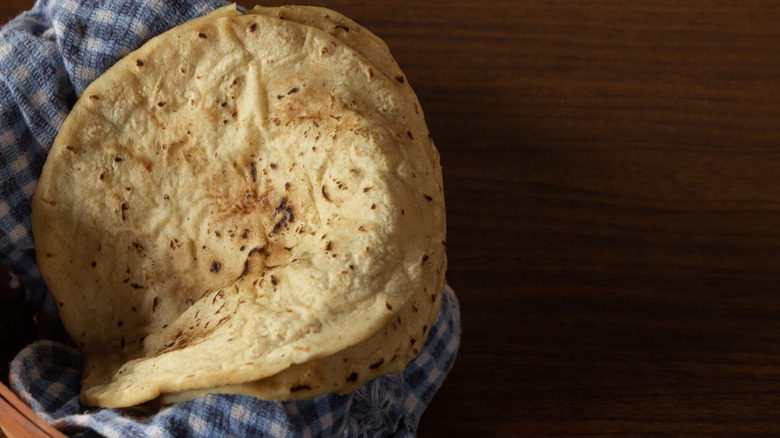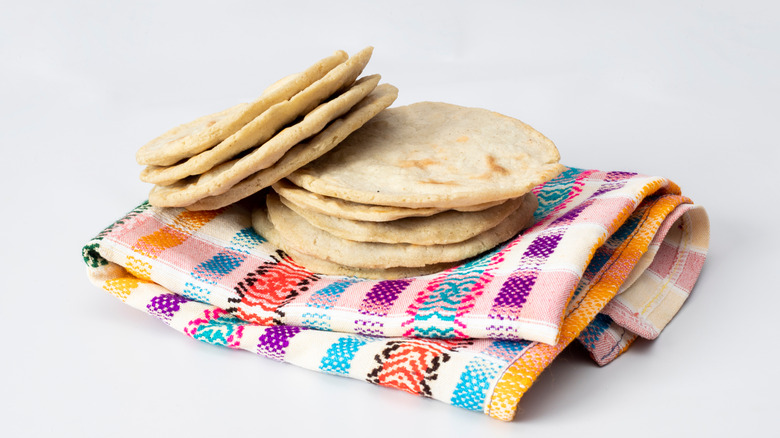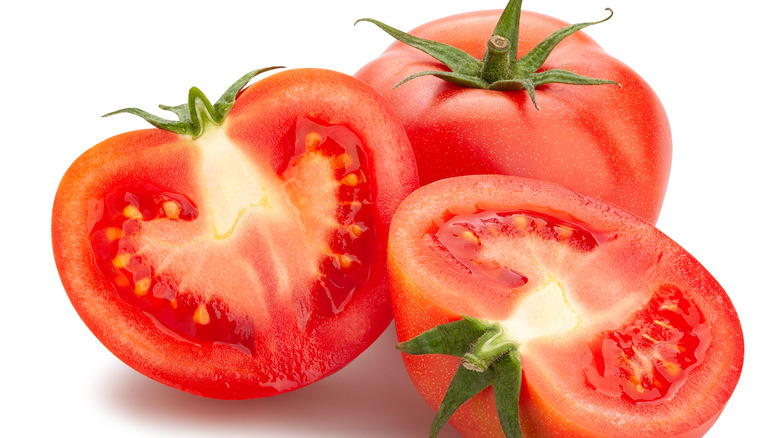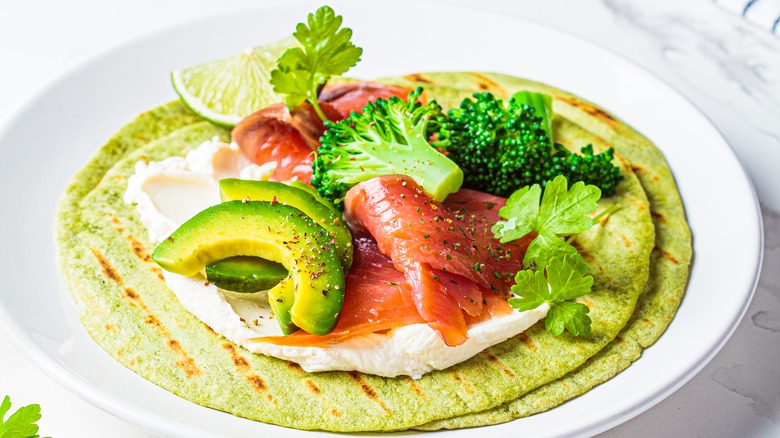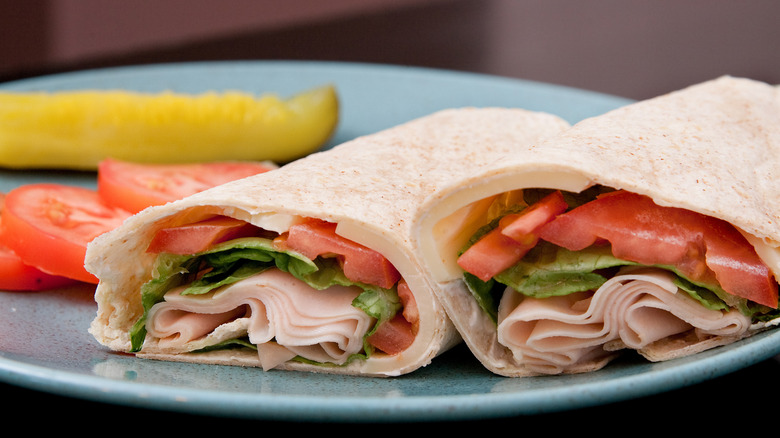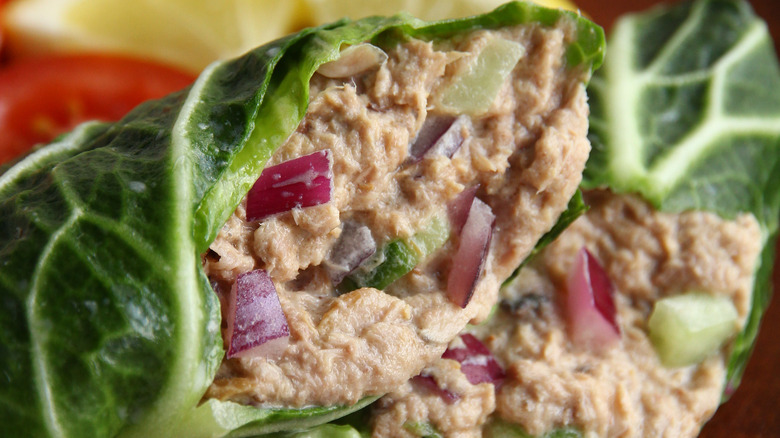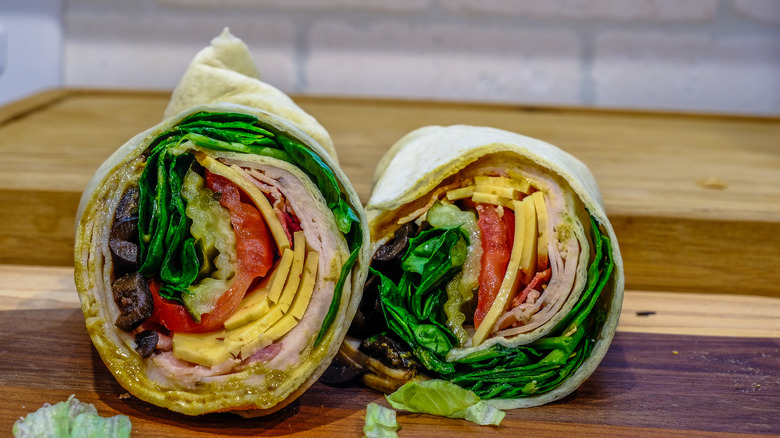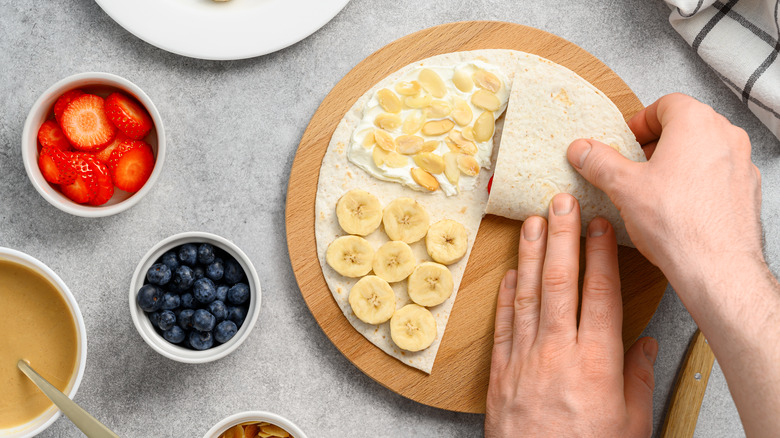Mistakes Everyone Makes When Making Wraps
Wraps are tasty, convenient, and flexible; you can put just about anything on soft flatbread, roll it up, and eat it without getting the filling all over your hands. Filling wrapped in something carby shows up in just about every cuisine, from burritos to kati rolls, and the "wrap," that rolled-up sandwich relative that is often eaten cold, has become a mainstay in U.S. cooking.
The exact origin of the "wrap" is a subject of debate. According to The New York Times, some people point to former Boston Red Sox manager Bobby Valentine as the inventor. As Valentine explains it, back in 1982 the toaster at his restaurant broke unexpectedly, so he wrapped sandwich ingredients in a tortilla as a substitute. He didn't call it a wrap, but others did, and the name stuck. Others point to two different restaurants as the inventors, although one used a different name.
Regardless of the wrap's beginnings, it's become a mainstay of menus and recipe lists. Beyond being tasty and filling, they are simple to put together, but if you try to create a wrap without knowing the correct method, you can end up with your lunch in your lap. Here are some common mistakes to avoid the next time you're putting together a wrap.
Placing the filling in the center of the wrap
When you have a big tortilla or flatbread in front of you, it's natural to think that any fillings should go in the center. (For the sake of simplicity, we'll use "tortilla" throughout the article, but remember that you can use other thin flatbreads, too.) That looks better from your perspective and mimics what you learned when you learned to make sandwiches with two pieces of bread. However, placing the filling in the center of the wrap leaves you with a huge section of tortilla on either side, and when you try to roll up the wrap, you end up with an awkward bundle that has too much bread in some places and not enough in others. You could tuck the edge of the tortilla under the filling, but that gets messy.
Instead, place the filling off center, lower than the halfway point of the tortilla (via Epicurious). This makes it much easier to roll up the wrap and doesn't leave you with lumpy sections. Leave some empty space on the sides of the filling, too; a couple of inches is best if you want to ensure the filling doesn't ooze out from the ends. Start by folding the end closest to you over the filling or fold the sides over; both methods work, and you'll figure out which one you prefer. It may also help to flatten the pile of filling a bit, which will spread it toward the center, but not by much.
Using too much filling
The amount of filling you need for a wrap isn't always intuitive. A common mistake is placing too much filling on the tortilla because, in your mind, that amount is what you think will make the wrap a certain size when fully assembled. In reality, the finished wrap you hold gets its bulk from both the filling and the tortilla, which means you may need to ease up on how much filling you try to use.
If you truly want a lot of filling, get bigger tortillas. Regardless of the size of the bread, stick to covering no more than one-third of the bread with the filling (via Toufayan). If you have lunch meat, cheese slices, or similar ingredients, place them so that they cover the bottom half of the tortilla up to about the center. When you roll up the tortilla and cut it in half, you'll see the slices alternating with the bread, balancing the amount of filling and tortilla you get in each bite.
Not using the right material to enclose meal-prepped wraps
If you make a wrap to eat right then and there, you don't really need any exterior (non-edible) wrapping or sleeve, although a paper towel can help keep your hands clean as you hold onto the wrap. However, wraps are really easy to make ahead of time, such as for lunches during the week. To store these extra wraps so that they don't fall apart, you'll need to use an exterior wrapping material to prevent the wrap from drying out. Unfortunately, many people turn to plastic wrap or plastic bags for storage, which makes the wraps soggy (via Eatwell 101). Using parchment paper or even wax paper helps the wrap stay fresher.
When storing a wrap in paper, use the same method you'd use for wrapping subs: Position a large square of paper so that one corner points toward you (Serious Eats suggests the paper should be about one-and-a-half times the length of the wrap). Put the wrap a couple of inches above the point and fold the corner over the wrap. Roll the wrap and paper all the way to the other corner, stopping to fold both sides of the paper in before you reach the end of the paper. (Yes, the method for rolling up the parchment or wax paper is similar to how you'd roll up a tortilla for the wrap itself.) Ensure the paper is wrapped snugly around the wrap and seal with a small piece of tape.
Not warming up the tortilla
Warming up the bread that you'll be using to create the wrap makes it more pliable. You don't have to make the bread hot; just get it warm enough so that it's easy to fold and doesn't fight to unfold. You can microwave it for a few seconds or toast it in a skillet; the method doesn't matter as you'll just need to do it for only a very short time. If you use a skillet, you can heat the tortilla dry or, per Epicurious, with a little oil brushed on each side. Just remember to keep a close eye on the tortilla. Turn it once, and do not let it crisp up into a giant tortilla chip!
The oven is also an option and allows you to heat up multiple tortillas at once, but it will take longer and require more preparation. If you prefer the oven, then wrap the tortillas in foil and heat for 15-20 minutes at 350 F (via Kitchn). However, the microwave and stovetop-in-a-skillet methods are better if you're into fast meal preparation.
Using a tortilla that's too thick
If you like to make your own tortillas, watch out for how thick you're making them. If they're too thick, the tortillas won't be flexible enough to wrap around the filling, even if you warm them up first. The wrap you use needs to be soft and very pliable so that it can bend without tearing or cracking, and it's easier to get that texture with thinner breads.
Another problem with homemade tortillas, as delicious as they are, is that it is easy to cook them for too long (via Baking Kneads). They become dry, stiff, and even crispy before you realize what happened. As you'd expect, cooked tortillas can stiffen as they cool down, so if you plan to use the tortillas immediately for wraps, place the cooked tortillas in foil to help retain the warmth as you get the wrap fillings ready.
The filling is too wet
Watery sauces and washed greens that weren't thoroughly dried can make your wrap soggy and lead to leaks as the liquid softens the bread, allowing the liquid to seep out. While tortillas are generally great about absorbing a little excess moisture, too much moisture leads to disintegration. Make sure all the non-sauce ingredients are relatively dry; deseed tomatoes and let the tomato slices rest in a strainer or on a paper towel for a few minutes, dry off lettuce, drain excess oil from cooked-meat fillings, and so on.
If any cooked ingredients will make other ingredients melt, like cheese, be careful not to put too much of those ingredients in the wrap. As for sauces and spreads, use a thin layer only. Too much sauce or spread only results in the excess oozing out of the bottom of the wrap half as you try to hold the thing together.
Not using some kind of sauce or spread
Don't go too far in the other direction and create an overly dry wrap to avoid leaks; you do need some moisture. One of the factors contributing to a dry filling is a lack of sauces or spreads. Whether you want mustard or another condiment or sauce, that ingredient will help add moisture to the bites you take. It will also conveniently act as glue for the ingredients you put on top of it, helping to hold those ingredients close to the bread (via Land O' Frost).
As a final strategy, use a little of the sauce or spread to seal the end flap when you're done rolling up the wrap. And if you're creating a dessert wrap, Nutella or another nut butter would be a perfect pick. No matter your choice of sauce or spread, make sure the dollop you use as a seal is hidden under the flap so it doesn't get on your fingers as you hold the wrap.
Wrapping too loosely
Sauces and spreads go only so far in terms of holding a wrap together. If you want all of the ingredients in that wrap to stay put, you need to pack them in well and roll that tortilla up very tightly (via Uno Casa). You want to avoid tearing the bread (which is why you really need to warm it up first), but you also don't want a loose wrap — that's a recipe for spilled ingredients.
As you roll up the wrap, go slowly at first (you can speed up as you get more practice) and make sure you're not leaving a lot of air inside the wrap. It's okay to start over if you notice the tortilla starting to tear or if you think the filling isn't secure; try folding in the sides first if you previously folded the bottom end up first, and vice versa, because one method might be easier for you. None of the filling should feel loose or shift around once the tortilla is rolled up.
Not trying alternatives
If you like using tortillas or other flatbreads in the wrap, we're not going to stop you. But do consider using greens that have large leaves, such as iceberg lettuce, kale, or collards, instead of bread. These leaves, especially when lightly steamed, are just as pliable and much better at not becoming soggy (via Kitchn).
If you want to try this, take a large, washed leaf and trim off the stiff stem. (You might have to cut into the leaf a little to remove the whole stem; that's fine.) Blanch or steam the leaf if it feels stiff and doesn't roll well, although many leaves, especially lettuce, don't need prior blanching or steaming. Dry off the leaf thoroughly, especially if you blanched it, and then add fillings and roll up your wrap as if you were using a tortilla. You can try this recipe for a simple falafel collard wrap to start.
Making the wrap without considering nutrition
Wraps are meant to be a main course, and while they don't have to contain a perfect ratio of protein, fats, fiber, and carbs, you want to have some sort of nutritional balance. Not only is that better for your health overall, but it should taste better and give you more of a nutritional punch for the calories you're eating.
Bulk them up with crunchy lettuce and carrots, juicy (but strained and deseeded) tomatoes, sweet carrot sticks, and other vegetables. Add lean meat, cheese, or a bean-based protein — or a combination — and you have a delicious and healthy meal (via Verywell Fit). Try different spreads, such as mustard instead of mayo, to find that flavor combination that stands out. Ensure you have at least one ingredient that provides the sensation of umami, such as parmesan (and remember that umami is not a flavor). You can play around with the tortilla as well, choosing high-fiber/low-carb versions or regular tortillas that have added vegetable powders for color.
Not making your wraps the way TikTok taught you
The classic wrap that comes to mind when you mention that word is one that looks like a cylindrical bundle of food inside a tortilla. Thanks to TikTok, though, the wrap now has a popular alternative form that looks like a thick, multilayered quesadilla, although it doesn't have to contain cheese.
The TikTok wrap hack is fairly simple: Place a tortilla on a cutting board and make a straight cut from one edge to the center of the tortilla, as if you were cutting along a line marking the radius of a circle. Place your ingredients in four piles, with each pile in a quadrant of the tortilla. Starting from the cut, flip one quarter of the tortilla up so that the filling on that part rests on the filling in the quarter that was next to it. Flip that stack over onto the third quarter, and then flip that onto the fourth (or flip the fourth back onto the stack, if you prefer). These wraps can be toasted lightly if you want.
